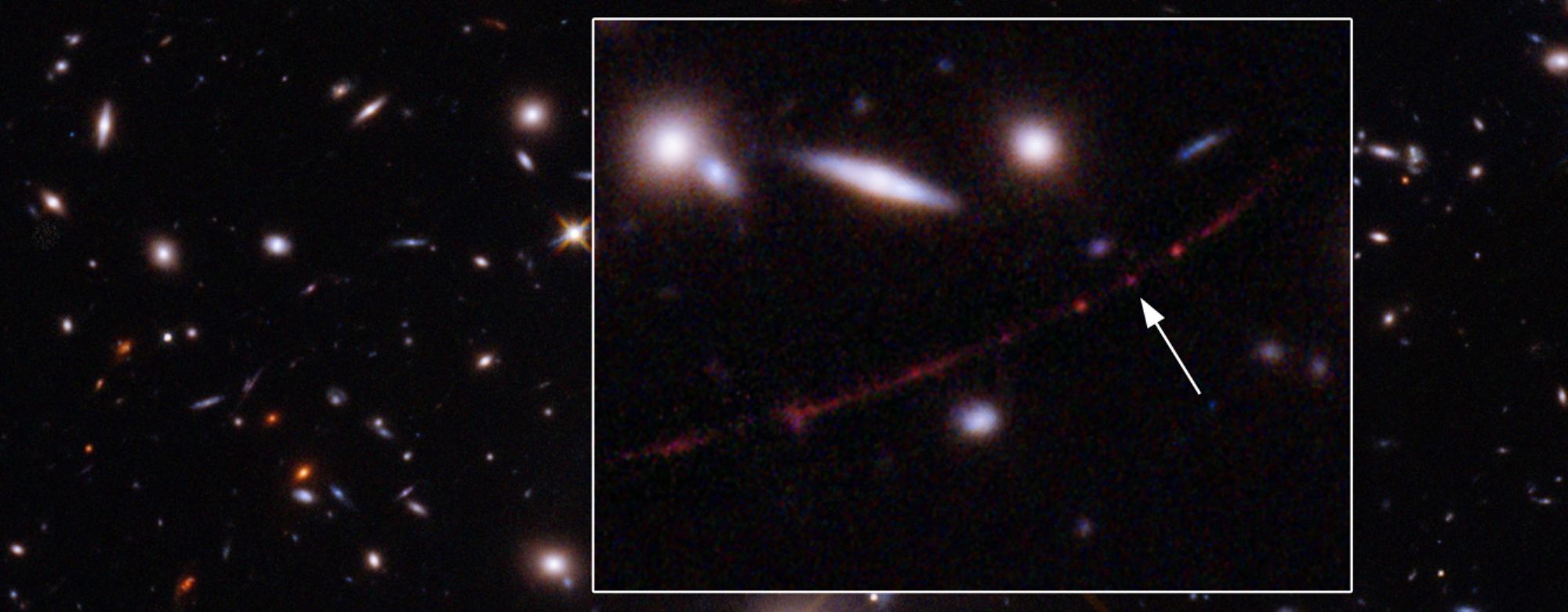A star that sounds as if it came from “The Lord of the Rings” now marks one of the Hubble Space Telescope’s farthest frontiers: The fuzzy point of light, known as Earendel, has been dated to a mere 900 million years after the Big Bang and appears to represent the farthest-out individual star seen to date.
Based on its redshift value of 6.2, Earendel’s light has taken 12.9 billion years to reach Earth, astronomers report in this week’s issue of the journal Nature. That distance mark outshines Hubble’s previous record-holder for a single star, which registered a redshift of 1.5 and is thought to have existed when the universe was 4 billion years old.
The newly reported record comes with caveats. First of all, we’re talking here about a single star rather than star clusters or galaxies. Hubble has seen agglomerations of stars that go back farther in time.
“Normally at these distances, entire galaxies look like small smudges, with the light from millions of stars blending together,” lead author Brian Welch, an astronomer at Johns Hopkins University, said today in a news release. “The galaxy hosting this star has been magnified and distorted by gravitational lensing into a long crescent that we named the Sunrise Arc.”
A close look at the arc turned up several bright spots, but the characteristics of the light coming from Earendel pointed to a high redshift, which translates into extreme distance. The higher the redshift, the faster the source of the light is receding from us in an ever-more-quickly expanding universe.
The observations were made as part of a Hubble program known as the Reionization Lensing Cluster Survey, or RELICS, led by study co-author Dan Coe at the Space Telescope Science Institute.
RELICS’ astronomers made use of gravitational lensing, a weird phenomenon in which a massive object such as a galaxy cluster bends and focuses the light coming from even more distant objects. The lensing effect results in magnified, arc-like images of far-flung stars, clusters and galaxies.
In the case of the Sunrise Arc, the lensing object is WHL 0137-08, a galaxy cluster that’s roughly 6 million light-years away in the constellation Cetus.
One fuzzy spot in the Sunrise Arc stuck out. The nickname that Welch and his colleagues gave to that spot, Earendel, comes from the Old English word for “morning star.” (It also evokes the name of Eärendil, who was a fictional half-elven mariner mentioned in J.R.R. Tolkien’s “Lord of the Rings” and “The Silmarillion.”)
Astronomers determined that Earendel was most likely an individual star system rather than, say, a star cluster. “We almost didn’t believe it at first, it was so much farther than the previous most-distant, highest-redshift star,” Welch said.
The research team estimates that Earendel is at least 50 times the mass of our sun and puts out millions of times more light. But plenty of mysteries remain to be resolved. For example, is it truly a single star, or is it actually a multiple-star system? And does it contain the same stuff that closer-in stars are made of?
If Earendel contains only the primordial elements of hydrogen and helium, it just might be the first known example of the first generation of stars born after the Big Bang.
Solving such mysteries is beyond the capabilities of the 32-year-old Hubble Space Telescope, but the recently launched James Webb Space Telescope could crack the case.
“With Webb, we expect to confirm Earendel is indeed a star, as well as measure its brightness and temperature,” Coe said. “We also expect to find the Sunrise Arc galaxy is lacking in heavy elements that form in subsequent generations of stars. This would suggest Earendel is a rare, massive metal-poor star.”
The research team has already booked time on the new space telescope, which is expected to begin science observations within the next couple of months.
What they find could take some of the shine off Earendel’s fame.
“We may see stars even farther than Earendel, which would be incredibly exciting,” Welch said. “We’ll go as far back as we can. I would love to see Webb break Earendel’s distance record.”
Welch and Coe are among 29 authors of the paper published by Nature, “A Highly Magnified Star at Redshift 6.2.”
Lead image: The star nicknamed Earendel, indicated by the white arrow, is positioned along a ripple in spacetime that gives the image extreme magnification. Source: Hubblesite.org. Credit: NASA / ESA / Brian Welch (JHU) / Dan Coe (STScI) / Alyssa Pagan (STScI).

